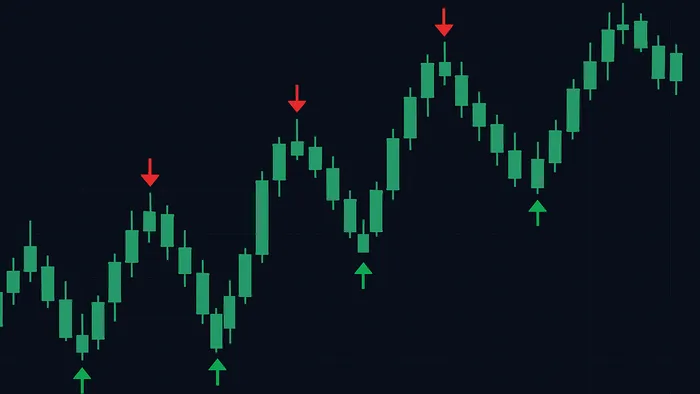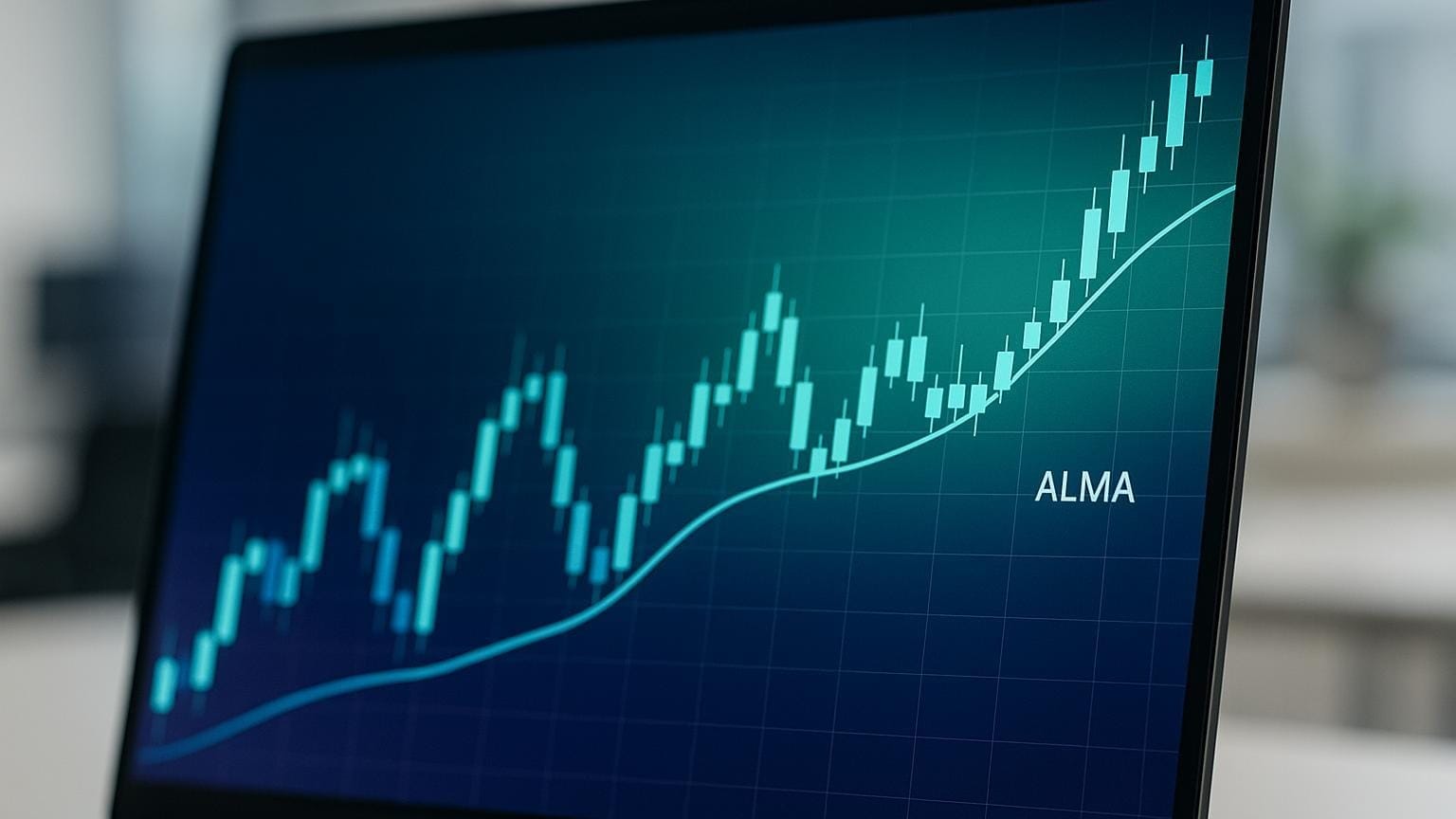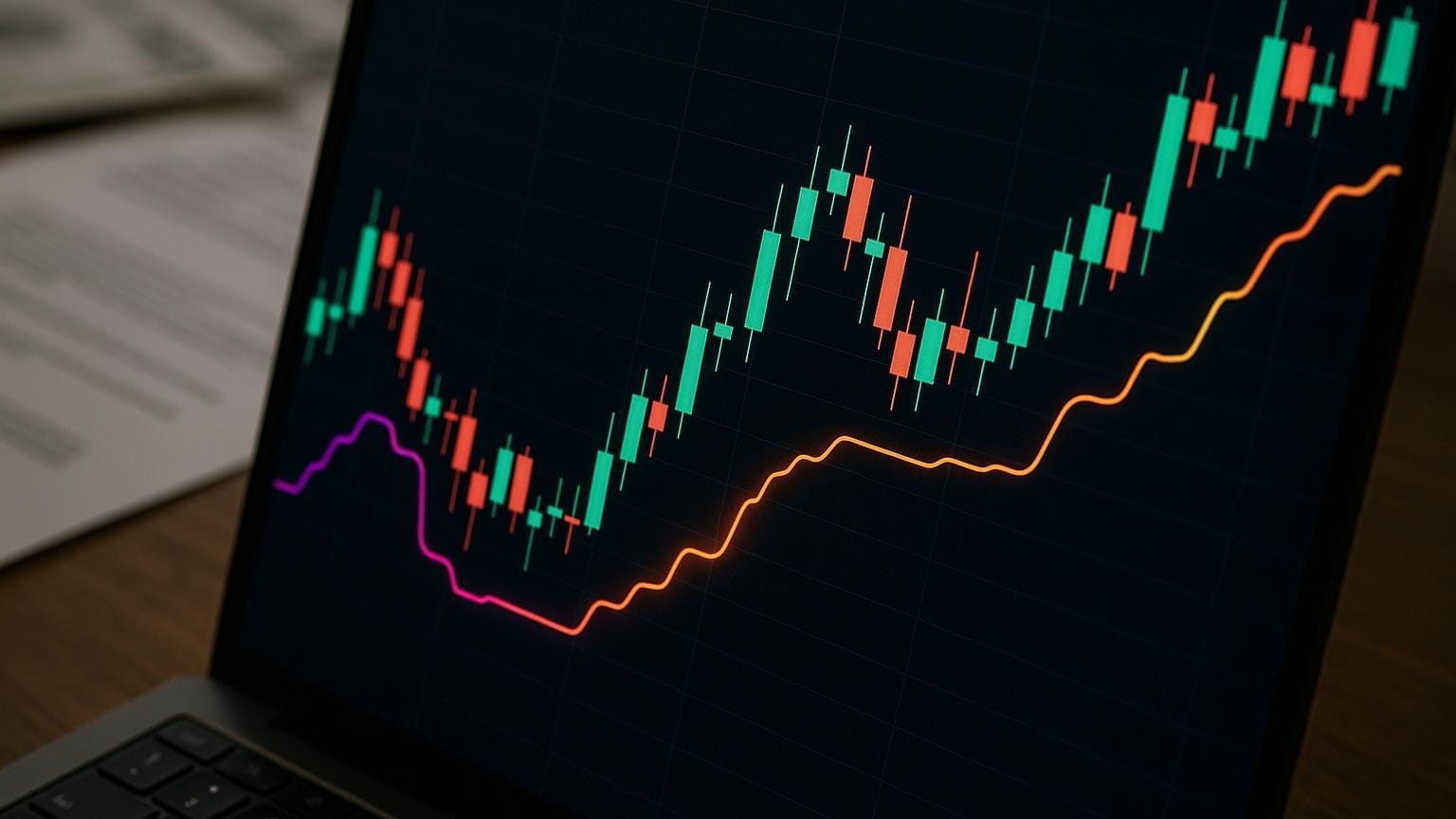Learn how the Williams Fractal Indicator can help traders identify potential market reversals and improve trading strategies through effective risk management.
The Williams Fractal Indicator is designed to help traders identify potential market reversals by highlighting key price patterns. Created by Bill Williams, this indicator uses a five-candlestick structure to pinpoint swing highs (bearish fractals) and swing lows (bullish fractals). These fractals are marked by small arrows on charts, providing clear visual signals for potential trend changes.
Key Takeaways
- How It Works: Identifies price extremes using a five-candle pattern. A bearish fractal forms at a local high; a bullish fractal forms at a local low.
- Lagging Nature: Fractals appear two candles after the turning point, making them a confirmation tool rather than a predictive one.
- Versatility: Works across all timeframes and asset classes, from forex to stocks and cryptocurrencies.
- Risk Management: Useful for setting stop-loss levels and identifying reversal zones.
Challenges
- False Signals: Common in choppy markets or without additional confirmation tools.
- Delayed Entry: Confirmation delay can result in less favorable trade entries.
- Overwhelming Signals: Shorter timeframes may generate excessive fractals, complicating decision-making.
Best Practices
To improve reliability, combine fractals with other indicators like moving averages, RSI, or volume analysis. LuxAlgo provides TradingView tools that enhance fractals with multi-timeframe analysis, backtesting, and customizable alerts. For terms without a LuxAlgo page, see resources like a primer on VWAP for context.
Bottom Line: The Williams Fractal Indicator simplifies price action analysis, but its effectiveness increases when used alongside complementary tools and strategies.
Fractals Explained – Price Structure
How the Williams Fractal Indicator Works
The Williams Fractal Indicator zeroes in on price extremes—those moments when market sentiment shifts—to identify potential trend reversals. By systematically recognizing these extremes, the indicator helps traders detect where a trend might change direction.
"In financial markets, the theory posits that these repeating patterns, or fractals, can indicate psychological points of reversal where price trends are likely to change direction." – Investopedia [1]
At its core, fractals highlight pivot points between buyers and sellers. When a fractal forms, it signals that one side of the market has temporarily taken control, creating a standout high or low in the price action. Let’s break down the specific structure that defines these signals.
The Fractal Pattern Structure
The Williams Fractal Indicator uses a five-candlestick pattern to pinpoint potential reversals. For a bearish fractal, which suggests a possible downward trend, the middle candlestick must have the highest high among the five. The two candles before and after it must display lower highs, forming a clear peak that hints at mounting selling pressure.
On the flip side, a bullish fractal indicates a potential upward trend. In this case, the middle candlestick must have the lowest low, with the two candles on either side showing higher lows. This valley-like pattern suggests growing buying interest.
The strict rules of this structure are what make it effective: either the pattern fits the criteria, or it doesn’t. However, because the fractal is only confirmed once the fifth candlestick closes, it’s considered a lagging indicator.
Calculation Method and Parameters
The indicator’s calculations are rooted in the five-candle structure. For bullish fractals, the third candle’s low must be lower than the lows of the surrounding four candles. Once confirmed, an upward-pointing arrow appears below the middle candle. Bearish fractals follow the opposite logic.
Traders can adjust the indicator’s sensitivity to suit their strategy. The default setting considers two candles on each side of the potential extreme, but increasing this count demands more surrounding candles with lower highs or higher lows. This adjustment results in fewer signals but can enhance reliability. Conversely, lowering the count generates more frequent signals, though it raises the risk of false positives.
Timing is critical. A fractal pattern isn’t valid until the fifth candlestick closes. If subsequent price action invalidates the setup, any unconfirmed fractal signals can disappear.
Common Interpretation Problems
The lag in confirming fractals presents challenges in fast-moving or sideways markets. One key issue is the risk of false signals when there’s no clear directional movement. In choppy conditions, fractals may appear frequently but lack reliability.
The two-bar confirmation delay can also make entries less favorable. By the time a fractal signal is confirmed, traders might find themselves buying above the market low or selling below the market high.
On shorter timeframes, the sheer volume of fractal signals can be overwhelming, especially in volatile markets. This abundance can dilute the importance of individual signals, making it harder to separate meaningful patterns from noise.
Stop-loss placement is another hurdle. Because fractal-based entries rely on delayed confirmation, they often require wider stop-losses, which can skew the risk-to-reward ratio.
"The premise is that market movements are influenced by traders' reactions to price changes, which tend to follow repetitive cycles because of human nature and collective memory. This cyclical behavior then creates patterns that can be recognized and used to predict market changes." – Investopedia [1]
Context is essential. A fractal that forms during a strong trend might have very different implications than one appearing in a consolidation phase. Ignoring the broader market environment can lead to trades that go against the prevailing trend.
To overcome these challenges, traders often combine fractal signals with other technical tools—like support and resistance levels, momentum oscillators, or volume analysis—to confirm decisions. Patience and a well-rounded approach are key to making the most of fractal-based strategies.
Trading Strategies Using the Williams Fractal
The Williams Fractal Indicator transforms price patterns into actionable trading opportunities. While understanding the mechanics is useful, the real edge comes from applying them effectively in live market scenarios.
Finding Reversal Zones
Fractals are excellent at pinpointing potential reversal zones where market momentum could shift. However, their significance depends on the broader market context and where they appear within it.
For example, bearish fractals near resistance levels suggest increased selling pressure, while bullish fractals at support levels point to renewed buying interest. These signals become stronger when fractals align with multiple key levels, creating confluence often respected by larger participants.
The timeframe you’re using also matters. A fractal on a daily chart reflects a more pronounced sentiment shift than one on a 5-minute chart. Weekly fractals might indicate major trend reversals lasting months, while hourly ones often signal short-term pauses.
Volume is another critical factor. High trading volume accompanying a fractal suggests a meaningful shift in participation, as opposed to a temporary price spike caused by low liquidity.
Trend strength also influences reliability. In strongly trending markets, fractals often mark brief pullbacks rather than full reversals.
Setting Stop-Loss and Take-Profit Levels
Fractals offer clear reference points for managing risk, though their delayed confirmation requires careful planning when setting stop-loss orders.
Due to the two-bar delay in confirmation, it’s best to place stop-loss orders slightly beyond the fractal extreme, with a small buffer. For bullish setups, stops can be positioned a bit below the fractal low to account for brief price spikes.
When it comes to take-profit levels, many traders use a fractal-to-fractal approach, targeting the next significant fractal in the opposite direction. This approach can work well in ranging markets, where prices oscillate between established highs and lows.
Another method involves using multiple take-profit levels. For instance, take partial profits at the first resistance level after entering on a bullish fractal, while letting the rest run toward a more distant target.
Position sizing is equally important. Since fractal-based stops often require a wider margin, reducing position size helps maintain consistent risk.
Combining Fractals with Other Indicators
To improve reliability, pair fractals with other tools.
- Moving averages provide trend context. A bullish fractal near a rising average carries more weight. For background on the Alligator, see Williams Alligator explanation.
- Fibonacci retracement levels complement fractals when patterns form near key ratios.
- Momentum oscillators like RSI or MACD can confirm signals; for RSI basics, see Relative Strength Index overview.
- Volume indicators add confirmation when accompanied by spikes.
- Support and resistance levels from prior price action provide added validation.
Patience and confirmation are key when trading with fractals. Combining trend, momentum, and volume data creates a more adaptable strategy.
Using Williams Fractals with LuxAlgo

LuxAlgo provides TradingView tools that take fractal-based trading strategies further by combining Williams Fractal signals with features designed to improve trading accuracy. Through enhanced visualization, automated backtesting, and a collaborative community, LuxAlgo helps transform basic fractal signals into a robust workflow for decision-making.
Fractal Features Available on LuxAlgo
The Signals & Overlays Toolkit on TradingView does more than identify fractals. It provides real-time, customizable signals that adapt to changing market conditions.
One standout feature is the ability to view fractal signals across multiple timeframes without switching charts.
Additionally, advanced alerts can notify traders when fractals form near key levels or during major moves. With the Custom Alert Creator, users can combine fractals with moving averages, RSI, or volume to receive tailored alerts.
Backtesting and Optimization Tools
LuxAlgo’s AI Backtesting Assistant enables validation of fractal-based ideas across assets and timeframes. Explore it here: AI Backtesting. It provides performance metrics to assess effectiveness.
The Signals & Overlays Backtester lets users fine-tune approaches by testing parameter combinations. Some plans include weekly updates with scanners, bots, and backtest insights, helping traders focus on promising opportunities.
Community and Strategy Sharing
LuxAlgo also emphasizes community. Educational resources on integrating fractals with other indicators and 24/7 support help traders adapt strategies to current conditions.
Pros and Cons of the Williams Fractal Indicator
The Williams Fractal Indicator is widely used in technical analysis, offering both advantages and challenges. Understanding its strengths and limitations can help you decide how best to incorporate it into your plan.
Benefits of the Williams Fractal
One standout feature is its simplicity. Fractals automatically appear on charts without complex inputs, making them approachable for beginners and experienced traders alike.
Another plus: it works across asset classes. Whether you trade stocks, forex, commodities, or crypto, the pattern remains consistent because it relies on price action.
The indicator provides clear visual cues for potential reversals. When a fractal appears at a critical support or resistance level, it’s easy to spot on any timeframe.
Fractals also offer objective signals. They either form or they don’t—reducing subjectivity. Additionally, confirmed fractals are non-repainting, which supports backtesting and historical analysis.
Drawbacks and Best Practices
The two-bar confirmation delay can be problematic in fast markets. By the time a fractal is confirmed, entries may be later than ideal.
Choppy markets can produce frequent false signals. Without additional tools, differentiating strong from weak reversals is difficult.
To address these issues, combine fractals with trend-following indicators or trendlines to filter counter-trend signals.
Wait for further confirmation before acting. Look for volume spikes or candlestick patterns to validate reversals. Choose timeframes that fit your style.
Comparison: Standalone vs. LuxAlgo Integration
The differences between using the Williams Fractal Indicator on its own and integrating it with LuxAlgo highlight how additional capabilities can enhance functionality:
| Feature | Standalone Williams Fractal | LuxAlgo Integration |
|---|---|---|
| Signal Accuracy | Basic fractal detection with more false signals | Improved filtering with multi-indicator confirmation and customizable settings |
| Timeframe Analysis | Manual switching between charts | Multi-timeframe analysis within a single interface |
| Alert System | Basic alerts for fractal formations | Advanced alerts combining fractals with key levels and other indicators |
| Backtesting Capability | Manual analysis only | Automated backtesting with performance metrics and optimization tools |
| Customization Options | Fixed 5-bar structure | Adjustable parameters and sensitivity settings |
| Market Context | Limited to price action | Includes volume, momentum, and trend indicators for deeper insights |
| Strategy Development | Trial-and-error approach | Access to community resources to accelerate iteration |
One notable advantage of integration is risk management. While standalone fractals provide entry signals, LuxAlgo adds tools for position sizing, stop-loss placement, and target setting informed by historical data and current conditions.
Another key benefit is real-time adaptability. LuxAlgo helps traders fine-tune strategies as conditions shift—transitioning between trends and ranges or navigating periods of elevated volatility.
Conclusion
The Williams Fractal Indicator offers a practical approach to spotting trend reversals with its five-candle pattern. By clearly highlighting swing highs and lows, it simplifies identification of turning points.
Its value increases when combined with other tools. On its own, it may produce frequent signals, including false positives. However, pairing it with complementary indicators from LuxAlgo can boost reliability and precision, improving signal accuracy and risk management.
To get the most from the Williams Fractal Indicator, recognize its patterns and integrate them into a broader system that plays to its strengths while addressing limitations.
FAQs
How can traders use the Williams Fractal Indicator with other tools to confirm trend reversals and reduce false signals?
To refine accuracy and minimize false signals, traders often pair the Williams Fractal Indicator with other tools like moving averages, RSI, or Fibonacci retracement. These tools add an extra layer of confirmation for potential trend reversals. For a quick primer on volume-weighted context, see how VWAP is interpreted.
Fractals can also be combined with trend-following indicators such as the Alligator or VWAP to determine market direction. Adding volume analysis or momentum oscillators can help cut through noise, particularly in choppy markets.
How can traders manage the risks of delayed confirmation when using fractal signals?
When dealing with delayed confirmation, combining fractals with other technical tools can help. For example, pairing fractals with moving averages, the Relative Strength Index (RSI), or Fibonacci retracements can reduce false alerts. Looking at higher time frames helps cut short-term noise.
Equally important is maintaining strict risk management through position sizing, stop-loss orders, and a clear trading plan.
How does the Williams Fractal Indicator work in trending versus sideways markets?
In trending markets, the indicator can highlight potential reversal points by identifying swing highs and lows, making it useful for spotting continuations or shifts. In sideways or choppy markets, it often produces false signals, as frequent formations may not lead to significant changes. For background on trend vs. range behavior, see trending market characteristics.
To navigate choppy conditions more effectively, combine the Williams Fractal with momentum indicators or support and resistance levels to filter noise.
References
- Reversal Signals
- Candlestick Structure
- Liquidation Levels
- Reversal Probability Zone Levels
- Understanding Moving Averages
- Volumetric Toolkit
- Multi-Timeframe Market Formation
- Signals & Overlays Alerts
- Pivot Point Profile
- Price Action Concepts
- Support & Resistance Dynamic
- Adaptive Momentum Oscillator
- Market Structure (CHoCH/BOS) – Fractal
- LuxAlgo Backtesting Features
- AI Backtesting Assistant
- External Resources
- Fractals: What They Are and How to Use Them
- Volume Weighted Average Price (VWAP)
- Williams Alligator Indicator
- Relative Strength Index (RSI)
- TradingView Platform








